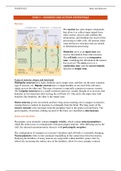PSY/IPN1023 Body and Behavior
TASK 2 – NEURONS AND ACTION POTENTIALS
Neurons
The neuron has some unique components
that allow it to collect input signals from
other sources, process and combine this
information, and distribute the result of this
processing to other cells. All neurons share
some distinctive structures that are related
to information processing.
Dendrites serve as an input zone and
receive information from other neurons.
The cell body serves as an integration
zone, combining the information the neuron
has received. The axon serves as a
conduction zone, and the axon terminals
function as output zone.
Types of neurons: shapes and functional
Multipolar neurons have many dendrites and a single axon, and they are the most common
type of neurons (A). Bipolar neurons have a single dendrite at one end of the cell and a
single axon at the other end. This type of neuron is especially common in sensory systems
(B). Unipolar neurons have a single extension (process), usually thought of as an axon, that
branches in two directions after leaving the cell body (C). One end is the input zone with
branches like dendrites, the other is the output zone.
Motor neurons govern movement and have long axons reaching out to synapse on muscles,
causing them to contract in response to commands from the brain. The long axons of the
sensory neurons carry messages from the periphery back to the spinal cord and brain. The
great majority of neurons, making up most of the brain, are classified as interneurons.
Axons and dendrites
Presynaptic axon terminals contain synaptic vesicles, which contain neurotransmitters,
which the neuron uses to communicate with postsynaptic neurons. After diffusing across the
cleft, the released neurotransmitter interacts with postsynaptic receptors.
The configuration of synapses on a neuron’s dendrites and cell body is constantly changing.
Neural plasticity refers to the continual remodelling of the connections between neurons.
Studying the dendrites of many neurons are outgrowths called dendritic spines, that, by
effectively increasing the surface area of the dendrites, allow for extra synaptic contacts.
, PSY/IPN1023 Body and Behavior
The axon arises from the axon
hillock. The axon hillock is
the neuron’s integration zone,
gathering and integrating
information from all the
synapses on the neuron’s
dendrites and soma.
With very few exceptions,
neurons have only one axon.
This solitary axon divides into
different axon collaterals,
allowing the neuron to
influence (innervate) a
number of postsynaptic cells.
The cell body manufactures
several materials, such as
enzymes and proteins.
Important substances needed
at the axon terminals are
loaded into transport vesicles.
Movement of material, called axonal
transport, works in both directions;
anterograde transport moves material
toward the axon terminals, and retrograde
transport moves used material back to the
cell. One action potential can only travel in
one way (due to refractory period; see later).





